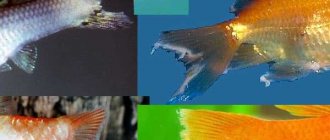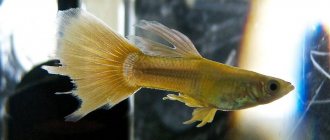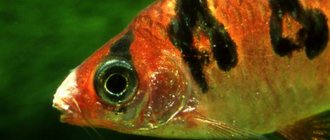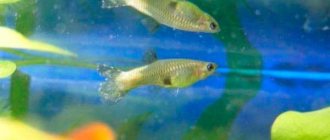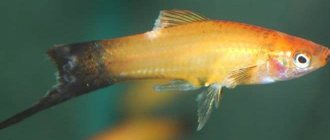Guppies are among the strong tropical fish and have good immunity. These popular inhabitants of home aquariums are unpretentious, rarely susceptible to disease and easily adapt to the most unfavorable conditions. Nevertheless, they, like all living things, can get sick from time to time. If the guppy is swimming vertically it requires serious attention. If fish behave this way, it is necessary to find out its reasons and take appropriate measures.
Changes in the composition and parameters of the aquatic environment
Very often, ornamental fish sink to the bottom of an artificial reservoir when the acidity level increases and the concentration of salts and mineral components increases. Such sudden changes cause a state of osmotic shock in the fish.
Similar problems can arise when moving new fish to another aquarium or using fertilizers or organic mixtures that are used to feed plant crops. In such cases, it is necessary to purchase a special test and check the water parameters in the aquarium. After this, clean the artificial pond and replace the water in it. It may also be necessary to introduce compounds designed to remove salts and metals from the liquid.
Postpartum behavior
Even the mother guppy can eat her offspring during spawning. After giving birth, the female should be returned to the general aquarium, and the fry should be left in the container until maturity. You can also protect them from their mother using a special partition.
There is no need to worry about separating the fish: they are designed in such a way that they do not need parental care and from the moment of birth they are able to feed and survive independently.
It is known that a female is able to become pregnant even an hour after giving birth, but more often the next offspring appears after 1–2 months. Females are able to give birth up to 8 times, being fertilized by one male, or can mate with others, producing a variety of offspring.
Relocation
Many ornamental fish have an extremely difficult time moving to another artificial body of water. In such cases, passivity and lying on the bottom are manifestations of severe stress or even a state of shock. According to experts, the acclimatization stage falls into the normal category, and therefore there is no need to worry too much.
The main thing is to first study the characteristics of a particular type of fish, their requirements for the aquatic environment and take care of creating optimal conditions for keeping them.
As a rule, after a few days the fish gets used to the new habitat, its condition improves, and, consequently, the level of activity increases. If your pet spends more than 3-5 days in a lying position, while breathing heavily and showing other painful signs, you should seek advice from a specialist.
Adviсe
Advice and treatment methods vary greatly from one source to another. Sometimes sellers in pet stores give harmful recommendations. Consult with experienced aquarists and veterinarians and check the information carefully.
(Visited 1,025 times, 1 visits today)
Changing the temperature
If the fish lies on the bottom, this may be a sign of temperature shock, which occurs in most representatives of ornamental species when the temperature of the aquatic environment drops to +5°C and below. It is important to monitor temperature indicators, especially when introducing new individuals into the aquarium.
After the temperature increases, the fish will gradually come to its senses. However, subsequently, the stress experienced can negatively affect her health, provoking the development of infectious, autoimmune diseases, weakening of the immune system and the body’s own protective resources.
Improper feeding
Reduced fish activity and other health problems caused by improper feeding are a widespread phenomenon among beginning aquarists. In no case should you overfeed ornamental fish, especially since most of them absorb and digest food at a slow pace.
Constant overeating threatens the development of obesity, which can even lead to the death of your pet. To avoid such unfavorable consequences, if there is a clear increase in the body weight of the fish, accompanied by low motor activity and staying at the bottom of the reservoir, it is recommended to temporarily move it to another aquarium, significantly reduce the diet and carefully monitor the feeding process.
It will be useful to arrange fasting days from time to time, which contribute to the accelerated stabilization of body weight and metabolic processes.
Diseases
Moving to the bottom, low activity, lethargy and apathy are dangerous symptoms, often indicating the development of deadly diseases. Many fish sink to the bottom due to disturbances in the functioning of the gastrointestinal tract or pathologies of the gallbladder.
Such illnesses can be provoked by pathogens that enter the body of underwater inhabitants along with water.
The penetration of single-celled organisms into the gall bladder area can lead to the death of the fish, so it is important not to start the process and carry out proper treatment in a timely manner.
If we are talking about representatives of large, predatory breeds of aquarium fish, then their desire to be on the bottom or in the ground is often observed after fights as a result of traumatic injuries. As a rule, injuries can be detected with the naked eye, but only a specialist should treat them.
Why do guppies freeze in the corner of the aquarium?
Read also: How to stop being afraid of offending people?
- Question: Guppies are too lethargic. They freeze in one place for a long time: in the corner of the aquarium near the surface, near the water flow of an aquarium filter or the air flow from a compressor. It seems that he has difficulty staying in a horizontal position - he wiggles his whole body violently. The dorsal fin and tail of the guppy are compressed as much as possible. Pays almost no attention to food. Only sometimes, as if with the last of his strength, he picks up a piece, but immediately spits it out.
- Answer: This is a real problem. And a problem clearly related to water quality. Either you have a new, recently launched aquarium with an unstable biobalance, or you simply neglect regular replacements.
- Guppies do not tolerate old water well. In addition, such symptoms begin to appear with any disturbance in the biobalance: when a whole group of new fish is introduced at the same time, during overpopulation, during insufficient operation of the filter, which simply cannot cope with toxins (ammonium, nitrates) and they poison the aquarium and all its inhabitants.
- If your guppy starts to behave this way, get ammonium tests done as soon as possible and, in any case, put fresh carbon in the filter canister. If the level of toxic substances exceeds, use any suitable aquarium chemical (for example, sera bio nitrivec ).
Breed Features
Beginner aquarists should know that for some species of fish, lying on the bottom of an artificial reservoir is completely natural and normal behavior. For example, catfish or corydoras swim all the time in the bottom layers of a reservoir and generally prefer to spend most of the day resting on soft ground.
Neons, fragile and sensitive creatures prone to traumatic injuries, also give preference to the lower layers of the aquarium. For this breed, the bottom of the tank is the most comfortable and safe habitat.
Cichlids, members of the loach family, also spend a lot of time digging in the soil of the aquarium. For them, such behavior is considered a manifestation of the norm in their natural habitat; they also dig up soil and aquatic plants. In addition, by wallowing in stones and soil, these types of aquarium fish cleanse their bodies of mucus, which can provoke the development of dangerous inflammatory processes.
Naturally, if the fish swims in the bottom layers of the reservoir when it was recently introduced into the aquarium.
This is explained simply. For a pet, a new aquarium is perceived as another world, unknown and fraught with potential danger. This behavior is especially typical for goldfish, representatives of the labyrinthine, cichlid, carp-toothed, and goldfish families.
Description
The parrot fish has a round, massive body shape with a pronounced head and a small mouth. The shape is similar to the structure of the beak of parrots. In some cases, some fish do not have their mouths closed or have difficulty doing so; this feature is a cost of selection. They can also include clumsiness; a heavy body makes it difficult to move smoothly, but on the other hand, this can be considered as another highlight of this type. The color is predominantly yellow, orange or red, other colors (purple, gray, pink, etc.) are less common. Wide fins are usually colored in body color.
Other reasons
Sometimes roars sink to the bottom under the influence of certain factors:
- dysfunction of the swim bladder (occurs with obesity, injuries, and some infectious pathologies);
- exhaustion of the body due to poor nutrition, hypoxia, the period of spawning and reproduction;
- psycho-emotional shock;
- feeling of approaching death;
- acidosis;
- alkalosis;
- natural processes of aging of the body, manifestations of age-related changes.
This behavior can also occur in fry that have used the yolk sac. Such babies, lying on the bottom, move around the aquarium with sudden movements. This symptom indicates a specific pathology, which, as a rule, goes away on its own as the individual grows older.
How to avoid problems
In order for the fish to feel comfortable and actively move around the aquarium without being in a lying position, it is important to create optimal, comfortable conditions for them. To do this, you should pay attention to the recommendations of experts regarding the arrangement of an artificial reservoir:
- Equipment. Most fish require additional lighting, filtration, and aeration. However, you should know how to properly use additional devices. When introducing new fish, it is recommended to include them a week after the completion of the acclimatization period.
- Soil – should be selected taking into account the characteristics and needs of a certain type of fish, which is planned to be populated.
- Pouring water should be done along the glass wall of the tank. After this, the water must sit for some time before fish can be introduced into it.
- Planting of aquatic and above-water green crops should be carried out several days after pouring water into an artificial reservoir.
- Timely cleaning of the tank and soil from food debris, waste products of aquarium inhabitants and other debris.
- Water replacement should be carried out weekly, approximately 25-30% of the total volume of liquid in the tank.
- Clean installed filters at least once a week.
- Complete cleansing of the artificial reservoir, including soil and decorative elements, should be carried out at least once over a period of 2-2.5 weeks.
- Compliance with the feeding regime and a varied diet (read more about how to feed aquarium fish).
- Carrying out periodic disinfection of an artificial reservoir.
Compliance with the rules listed above will help create the best conditions for the life and activity of aquarium fish, as well as protect them from the development of dangerous diseases that affect motor activity.
If the fish lies on the bottom, then this phenomenon can be caused by numerous reasons. First of all, it is worth checking the water parameters in an artificial reservoir, the temperature regime, and replacing the fluid. If the situation does not change within several days, then it is worth seeking advice from a specialist, since often a decrease in motor activity and the desire to stay as close to the ground as possible indicates the development of diseases that require mandatory treatment.
Fish freeze at the surface and die
Hanging at the surface and swallowing air from it, as we have already said, indicates a lack of oxygen. If nothing is done, the fish will begin to die. Unfortunately, even experienced aquarium keepers cannot always avoid this. It must be remembered that the oxygen level in water is directly affected by:
- temperature;
- chemical composition of water;
- bacterial film;
- excess or lack of algae.
Not only changing the fluid and cleaning the filter helps correct the situation. Direct the water flow to the very top of the water - its fluctuations play a big role in gas exchange.

